
Campion Hall is one of the five permanent private halls of the University of Oxford in England. A Catholic hall, it is run by the Society of Jesus and named after Edmund Campion, a martyr and fellow of St John's College, Oxford. The hall is located on Brewer Street, between Christ Church and Pembroke College. The buildings, along with many of the fixtures and fittings, were designed by Sir Edwin Lutyens, his only buildings in Oxford. The hall also houses an extensive collection of religious art spanning 600 years; the pieces were collected primarily by Fr Martin D'Arcy in the 1930s.
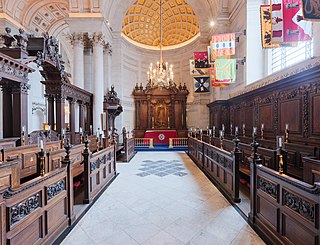
A chapel is a Christian place of prayer and worship that is usually relatively small. The term has several meanings. First, smaller spaces inside a church that have their own altar are often called chapels; the Lady chapel is a common type of these. Second, a chapel is a place of worship, sometimes non-denominational, that is part of a building, complex, or vessel with some other main purpose, such as a school, college, hospital, palace or large aristocratic house, castle, barracks, prison, funeral home, cemetery, airport, or a military or commercial ship. Third, chapels are small places of worship, built as satellite sites by a church or monastery, for example in remote areas; these are often called a chapel of ease. A feature of all these types is that often no clergy were permanently resident or specifically attached to the chapel.

A chaplain is, traditionally, a cleric, or a lay representative of a religious tradition, attached to a secular institution, or a private chapel.

Lancaster University Chaplaincy Centre, on the campus of Lancaster University in the United Kingdom brings together the many faith groups represented on the campus and in the wider community.

David John Conner, is a British Anglican bishop. He has served as Dean of Windsor since 1998, and was additionally the Bishop to the Forces between 2001 and 2009. He previously served as Bishop of Lynn, a suffragan bishop of the Diocese of Norwich, from 1994 to 1998, and in school chaplaincy. Conner has announced his intention to retire effective 31 July 2023.

Amport House is a country house near the village of Amport, Andover, Hampshire, England. It is a Grade II listed building.

The Roman Catholic Archdiocese of Southwark is a Latin Church archdiocese of the Catholic Church in England. It is led by the Archbishop of Southwark. The archdiocese is part of the Metropolitan Province of Southwark, which covers the South of England. The Southwark archdiocese also makes up part of the Catholic Association Pilgrimage.

The Newman Society: Oxford University Catholic Society is Oxford University's oldest Roman Catholic organization. It is a student society named as a tribute to Cardinal Newman, who agreed to lend his name to a group formed seventeen years before the English hierarchy formally permitted Catholics to attend the university. The society acquired its current form and title following the merger in 2012 of the pre-existing Newman Society and Oxford University's Catholic Society. It exists, according to its constitution, to 'work in conjunction with the Chaplains to support and encourage Catholic students in their Christian vocation by promoting their personal, intellectual and spiritual development, social interaction, and apostolic witness within the broader context of their university experience', and has served as the model for Catholic students societies throughout the English-speaking world.

Douglas Geoffrey Rowell was an Anglican bishop, who served as Bishop of Basingstoke and then as the third Bishop in Europe until his retirement on 8 November 2013. Following his retirement he ministered as an assistant bishop in the Diocese of Chichester and in the Diocese of Portsmouth. He died in the early morning of Trinity Sunday, 11 June 2017.
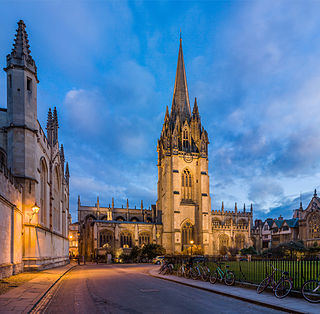
The University Church of St Mary the Virgin is an Oxford church situated on the north side of the High Street. It is the centre from which the University of Oxford grew and its parish consists almost exclusively of university and college buildings.
Roger Francis Crispian Hollis is the Bishop Emeritus of Portsmouth for the Roman Catholic Church.
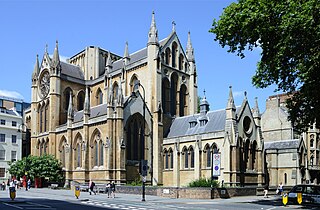
The Church of Christ the King belongs to Catholic Apostolic Church trustees; it is in Gordon Square, Bloomsbury, London. It adjoins Dr Williams's Library and is within sight of University College London. The church is used by the Anglican mission Euston Church for Sunday services and its English Chapel, at its east end, by Forward in Faith for weekday services. It has been a Grade I listed building since 10 June 1954, one of 129 such Christian buildings in London.
Peter John L'Estrange, AO is an Australian Jesuit priest and historian. He was the Master of Campion Hall at the University of Oxford in England from 2006 to 2008.
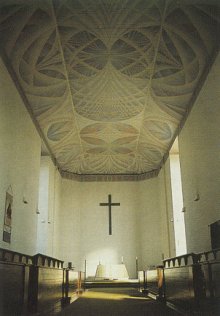
The Mary Harris Memorial Chapel of the Holy Trinity is the Anglican Chaplaincy's chapel on the Streatham Campus of the University of Exeter. It is located at the heart of the campus, beneath Queen's Building and adjacent to the Old Library and the Roborough Building.
Augustine John Hodson was the first Bishop of Tewkesbury from 1938 until his resignation in 1955.
Alfred Newman Gilbey (1901–1998) was a British Roman Catholic priest and monsignor. He was the longest-serving chaplain to the University of Cambridge, England. He has been described as the best-known Roman Catholic priest in England during the last quarter of the 20th century.
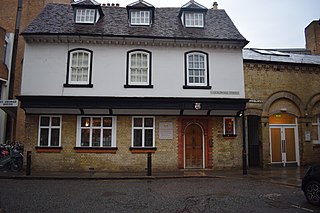
The Cambridge University Catholic Chaplaincy, known as Fisher House after its patron, English martyr and Cambridge chancellor St John Fisher, is the Catholic chaplaincy for members of the University of Cambridge in England. Founded in 1896, since 1924 it has been located on the site of a former inn on Guildhall Street in Cambridge's city centre. The present Chaplain is Fr Paul Keane.
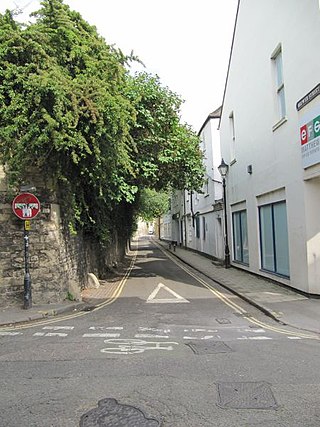
Brewer Street is a historic narrow street in central Oxford, England, south of Carfax. The street runs east–west, connecting with St Aldate's to the east and St Ebbe's Street to the west.

St Cuthbert's Church is a Roman Catholic parish church in Durham, England. It was opened on 31 May 1827 to replace two previous chapels, one run by the secular clergy and the other by the Jesuits. It is also the home of the Durham University Catholic Chaplaincy and Catholic Society. From 2012 to 2016 the parish was entrusted, along with the chaplaincy, to the Dominican Order, and its congregation has since maintained the Dominicans' influence. The church is a protected building, being part of the Elvet Green Conservation Area. It is named for St Cuthbert of Lindisfarne, the 7th century bishop, healer and patron of Northern England.

St Albert's Catholic Chaplaincy is the Roman Catholic chaplaincy for the University of Edinburgh. It started in 1931, when the Dominican Order moved into the house. It is located at 23 and 24 George Square, south of the city centre, and north of The Meadows. The original building is category A listed and the chapel, built in 2012, won an award for architectural excellence from the Royal Institute of British Architects.



















